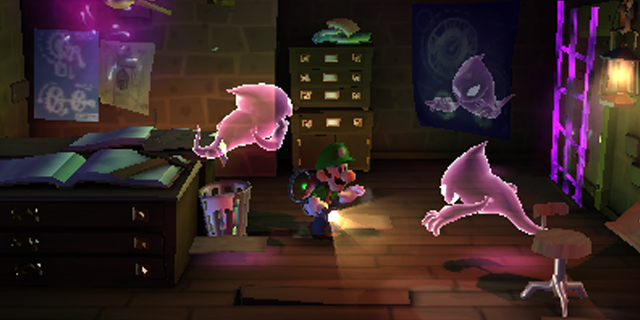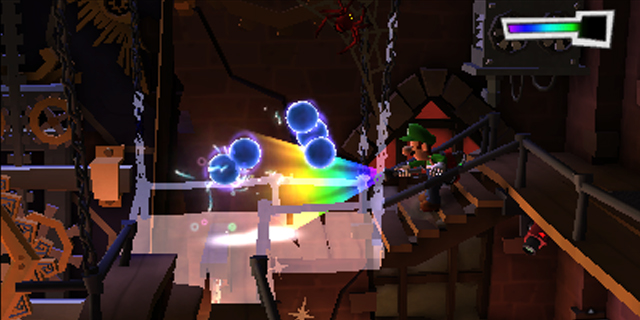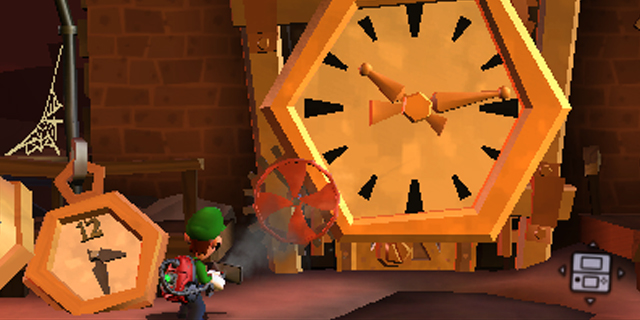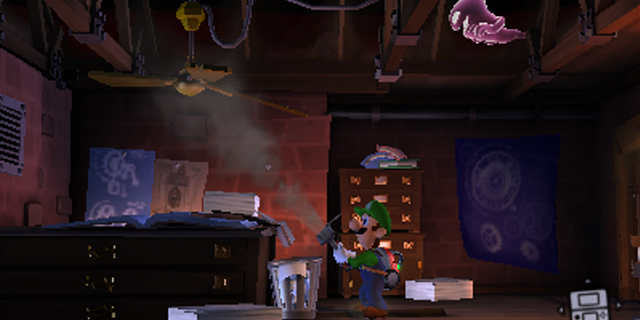
Luigi may be portrayed as the underdog or second fiddle to his older brother in a lot of games, but in all fairness, he’s had a pretty great career. He gets to help Mario out without drawing the ire of Bowser. He travels around the globe, teaching children about famous artifacts along the way. John Leguizamo played him in a Hollywood film. Imagine the royalty checks! No risk, all reward.
Then Nintendo had to ruin everything. Dropping him into a haunted house against his will and arming him with a vacuum cleaner of all things, he had no choice but to face the reality-bending horrors of the undead all for the sake of his brown-nosing bro. Over ten years later, just when he was getting used to taking it easy again, Nintendo took it upon themselves to drag him back into the spotlight by slapping his face over the entirety of 2013. The nerve! And of course the first thing they do is throw another vacuum in his face.
What made Luigi’s Mansion so important to the Nintendo canon was the establishment of Luigi as his own character. Before that, he was just another yapping face in the party and sports spinoffs, and before that he may as well have been a palette swap. Mario is Missing jokes aside, Nintendo really breathed life into the green guy in his first major starring role. Exploring the possible reasons for his position as player two, they went with the idea of making him a bit of a coward. In a comic sort of way, of course.

The benefit to that kind of role in that kind of game: portraying Luigi as a scaredy-cat who grows more confident as the game progressed allowed a lot of room for depth in the animations. Nintendo historically keeps its characters largely wordless, so in order to establish Luigi as a character, they had to go a little beyond stamping a big doofy grin on his face and making him “yahoo” all the time.
Now that we’re revisiting the haunted mansion setting and Luigi has developed further into his own (thanks to the Mario and Luigi series), Nintendo had to step up its game. And boy howdy, did it pull it off with flying colors. I don’t think I’ve seen such an expressive protagonist in a game since Wind Waker, and Luigi’s Mansion: Dark Moon blows that out of the water in this respect. Luigi is alive; his entire face is fluidly animated: eyes, nose, mouth, even his eyebrows. His body language is exaggerated to great effect. His pudgy body flaps about wildly when he runs, and is the unfortunate subject of (hilarious) slapstick comedy throughout.
His terrified reactions to the ghosts he encounters and shameless boredom whenever Professor Gadd rambles directions are varied and equally priceless. If it weren’t for some of the understandable technical drawbacks (though the style and depth of the visuals thanks in part to the 3D are stellar), I’d swear I was watching a high-profile animated movie. What was started in the first game and polished in the Mario and Luigi games has now been perfected: Luigi now possesses more depth than any other resident of the Mushroom Kingdom.

The major worry I had when approaching Dark Moon was mechanical. The first Mansion was designed explicitly for Nintendo’s first foray into dual-analog controls. The GameCube’s responsive C-stick was used to aim Luigi’s flashlight and vacuum, while the main stick could focus entirely on movement. Here, only one circle pad is available. What developer Next Level Games came up with to compensate usually works. Aiming is largely reliant on the direction Luigi is facing, but either with the 3DS’s gyroscope (don’t bother) or the X and B buttons, vertical movement is possible. Luigi is also afforded slight auto-tracking to the side. It isn’t enough to cheapen the challenge, but enough to throw you a bone if your aim isn’t perfect. It often won’t be.
The controls can be cumbersome in a pinch. Avoiding opportunistic ghosts while trying to suck up another in close quarters can involve a lot of letting go and running away to reposition yourself, but for the most part you just need to get a feel for it. The more puzzle-oriented functions of the Poltergust are brilliant. New tools and ways to solve puzzles are always cropping up, keeping you on your toes with each new mansion (yes, you get to de-ghost multiple mansions this time!) as well as giving you new options for exploration.

What does end up hindering Dark Moon is the mission-based level structure. Before, Luigi’s Mansion was fairly linear, but you theoretically had the whole mansion at your disposal and could explore at your leisure. This time around, you’re limited by objectives that have you entering and exiting the mansions on completion. This really breaks up the flow of the game. It makes sense, with Dark Moon being a portable game and Nintendo going further with the 3DS lately to embrace the handheld format. Still, a game like this would have benefited more from a save-anywhere system that could break up game sessions but still allow the more immersive and less repetitive exploration that made the first game so great.
It isn’t that bad, but it hurts the game in two big ways. First, you end up going through big chunks of each mansion multiple times, either to pick up more money or just because the level design requires you to go through to get to each objective. Also, certain hidden collectibles can require replaying missions to get them, but if you accidentally meet a mission requirement before you find what you’re looking for you’ll have to restart. The mission structure doesn’t really serve to streamline or extend the game in any way, so it’s hard to accept why things have to be as they are.
Also interesting is the multiplayer mode. I wasn’t kidding when I described it on our podcast as “Luigi’s Mansion meets Mystery Dungeon.” The multiplayer pits up to four Luigis (which is as amusing as it sounds) in a tower of mansion floors, challenging them to work both together and against each other to clear each floor of ghosts. Each floor is randomly generated which adds to the frenetic silliness, and as you move up the tower, the ghosts inevitably grow stronger. It takes great skill to work with your partners to take out the strong boss ghosts as well as come out on top at the end, but even if the other jerk Luigis steal all your ghosts, it’s still fun to bumble around and run into things thanks to the game’s masterful characterization.
The year of Luigi is off to a great start, even if the poor guy’s workload has suddenly exploded. Dark Moon is great fun despite some problems, and includes plenty of options (download play!) to get a hold of people to try out the ridiculous multiplayer with. It is a very different beast from its predecessor, but undoubtedly a worthy successor. Now all we need is Mario is Missing 2, and everything will come full-circle.
Pros: Luigi is a spectacle in and of himself, multiplayer is a surprising treat
Cons: Mission structure is odd, controls require some practice



















